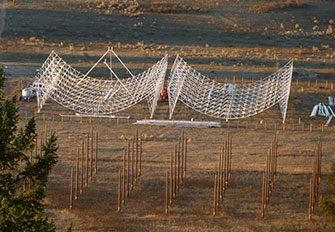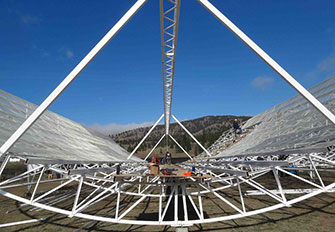Progress Report on the CHIME project from the Dunlap Institute’s Professor Keith Vanderlinde
The pathfinder or prototype, proof-of-concept for CHIME is well underway. (This is 2/5th of the completed CHIME). “One cylinder is essentially finished, the second is coming along, and we’re about to attach the first set of detectors. We’ve got several months of commissioning ahead of us before the whole thing is assembled and up & running, but things are certainly coming along,” Vanderlinde said.
The picture shows work-in-progress on a cylinder, as well as a glimpse of the pines dotting the hills surrounding the site. Pathfinder and CHIME are being constructed at the Dominion Radio Astronomy Observatory in the Okanagan Valley, British Columbia.
CHIME is an unprecedented experiment. It will make a three-dimensional map of the largest volume of the observable universe to date using a technique being pioneered in Canada, called Hydrogen Intensity Mapping.
Hydrogen is the most common element in the universe. The idea with CHIME is that you could use low resolution, fuzzy pictures of hydrogen massing to study the expansion history of the universe. You didn’t need to resolve galaxies, and so you could do more. CHIME will map about a quarter of the universe in a few years whereas we’ve mapped about 1 percent of the universe until now. It will chart the expansion beginning in the period when cosmic acceleration appears to have turned on, from something like 11 billion years ago (redshift 2.5) until ~6.5 billion years ago (redshift 0.8) .
The pathfinder pieces are the width of the CHIME cylinders. The completed CHIME will be a set of five 100-metre long x 20 metre half-pipes, lying side by side in a 100 metre-square array.
CHIME is a scientific collaboration of researchers at the Canadian Institute for Theoretical Astrophysics (CITA), the Canadian Institute for Advanced Research (CIFAR), the Dominion Radio Astronomy Observatory, the Dunlap Institute, the Universities of Toronto, British Columbia and McGill. It was funded by these institutions, their provincial governments and the Canadian Foundation for Innovation, Leading Edge Fund.
For the science behind CHIME see Chang et al. 2010, Nature, 466, 463, “An intensity map of hydrogen 21-cm emission at redshift z~0.8”
For an earlier article on this project, see the Globe & Mail

